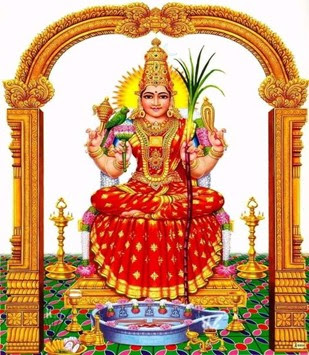The Divine Mother is truth, knowledge, and infinite bliss.
Brahman is truth, knowledge, and infinite bliss; the Divine Mother is Brahman.
The thing available but not permanent is not Satya. Due to time and place, if something is there at one time and disappears later, it cannot be Satya. Each universal being starts searching for food to keep it alive. They seek to be Satya but cannot be. The Divine Moter is far beyond and She is in Satya form; this explains this Nama.
Each soul tries to gain knowledge to prove its worth as knowledgeable. Plants and trees, without such knowledge gained, grow towards the light or sun. This is the indication of Jnana Shakti. This knowledge is available at high maturity levels. Only humans can achieve higher jnana and reach the Brahman. The Divine Mother with Jnana rupa resides in all universal beings,
All universal beings seek happiness. In the right surroundings, the plants have a pleasant life. As the soul reaches higher maturity, the desire for happiness increases and humankind is best at seeking happiness. In meditation, yogis gain Paramananda. The Divine Mother functions as Sat-chit-ananda Rupini, see name 700. All souls have come from Her and they try to reach that Sat-chit-ananda stage or Brahman.
Brahman is formless. But Satyam, Jnanam and Anandam identify such Brahman. The Divine Mother has these attributes within Her.
This Nama is interpreted also as follows: Sati+ajna + an-ananda + rupa with the meaning, “She who gives sorrow or pain to those who are ignorant (ajna) of truth and an-ananda wisdom (sati) to those with knowledge of the Brahman. Sati could also be Satidevi, the daughter of Dakhsa, who married Shiva; She is another form of the Divine Mother. Then She is the one who gives pain for those who are ignorant of Her true form. While jnanis get wisdom, the ignorant gets pain in this world, The Gita, chapter 18, makes it clear that all the physical pleasures which appear sweet at first, but turn out to be poison in the end.
The Divine Mother is truth, knowledge,
and bliss.
C
N Nachiappan
Singapore, 26 March 2022;
Updated 14 June 2025.
References:
1.
The Thousand
Names of the Divine Mother published in English by Mata Amritanandamis AparnaSan
Ramon, California, USA, with Commentary by T. V Narayana Menon
2.
Shri Lalitha
Sahasranama Stostram published in Tamil by N. Ramaswami Iyer charities’
societies, Trichirapalli, India, with Commentary by C. V. Radhakrishna Sastry.
3.
The Lalitha
Sahasranamam published in Tamil by Shri Ramakrishna Thapovanam,
Thiruipparaithurai, Trichy District, Tamilnadu, India with commentary by
Shrimath Swami Sithbavandar


No comments:
Post a Comment